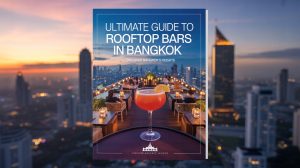If you’ve ever dreamed of a place where ancient temples shimmer at sunset, the scent of sizzling street food fills the air, and mountains cradle the city in a cool, green embrace – welcome to Chiang Mai!. But before you pack your bags, there are a few things to know before you go to Chiang Mai that can make the difference between a good trip and an unforgettable one. Too many travelers rush in with only a checklist of top attractions and miss the real soul of this northern Thai gem, such as the twilight glow over Doi Suthep, the warmth of chatting with market vendors, the calm of a riverside café, or the serenity of a hidden jungle temple. Skip the prep, and you might end up tangled in tourist traps, missing those magical moments that make Chiang Mai unforgettable. That’s where this guide steps in. Think of it as your personal travel compass, where we help you navigate temples, night markets, coffee culture, digital nomad buzz, wellness retreats, and mountain escapes with confidence. By the time you’re done reading, you won’t just know where to go , you’ll know how to feel truly at home in Chiang Mai. At-a-Glance Practical Info for Visiting Chiang Mai in 2025 Chiang Mai sits in the mountainous north of Thailand, in the Chiang Mai Province, and operates on Indochina Time (ICT), which is GMT+7. The local currency is the Thai Baht (THB), and Thai is the official language, though English is widely understood in tourist areas. For emergencies, dial 191 for police, 199 for fire, and 1554 for medical assistance. Getting to Chiang Mai is straightforward, with Chiang Mai International Airport (CNX) just 15–20 minutes from the Old City. Major airlines like Thai Airways, AirAsia, and Bangkok Airways connect the city to Bangkok in about 1 hour, while flights from Singapore take just over 3 hours. If you’re wondering how to get to Chiang Mai from Bangkok, you can also opt for overnight trains or buses for a scenic journey. Visa requirements depend on your nationality. Many travellers can enter visa-free for 30–45 days, while others need a tourist visa. For the latest rules, always check the official Thai Immigration website. As for vaccines, routine immunizations are recommended, and while COVID-19 or monkeypox checks are currently minimal, travel insurance is highly advised for peace of mind. Money matters are simple here. ATMs are everywhere, credit and debit cards are widely accepted in hotels, malls, and restaurants, but keep cash handy for markets and street food stalls. Tipping in Chiang Mai isn’t mandatory, but leaving small change or rounding up the bill is appreciated for good service. When to Go — Weather, Crowds & Events in Chiang Mai If you’re wondering what’s the best time to visit Chiang Mai, the answer depends on whether you’re chasing cool breezes, cultural festivals, or budget-friendly quiet months. Chiang Mai enjoys a tropical climate, with November to February bringing cool, dry days around 15–28°C and low humidity, which is absolutely perfect for sightseeing and outdoor adventures. March to May is hot season, with temperatures soaring to 35°C, while June to October is rainy season, marked by lush landscapes, afternoon showers, and fewer tourists. High season runs from November to February, when prices peak and popular temples, markets, and trekking spots get busy. Shoulder months like March, April, and late October offer a balance of fewer crowds and still-decent weather. Low season falls during the monsoon months, when accommodation deals are easiest to find, but you’ll need to plan around occasional heavy rain. Chiang Mai’s cultural calendar is a huge draw. In April, you have the Songkran festival, the Thai New Year water festival which turns the city into a giant street party. In November, Loy Krathong and Yi Peng see thousands of floating lanterns and sky lanterns light up the night in a magical spectacle. If you want to see the sky lanterns, plan your visit for Yi Peng and choose an event that uses biodegradable lanterns to minimize environmental harm. During the cool months, bring light layers for early mornings and evenings, along with temple-appropriate clothing that covers your shoulders and knees. If you’re travelling during the summer season, we advise you to bring breathable fabrics and strong sunscreen, while rainy season travelers should pack a light rain jacket, quick-dry clothing, and insect repellent. No matter when you go, comfortable walking shoes are a must if you are walking through Chiang Mai’s markets, temples, and alleys. Where to Stay in Chiang Mai — Best Areas for Every Traveler If you’re asking what’s the best area to stay in Chiang Mai, it really depends on your travel style. The Old City is perfect for first-time visitors who want to be surrounded by historic temples, charming lanes, and easy access to the Sunday Walking Street Market. Staying here means you can explore most sights on foot, with plenty of guesthouses, boutique hotels, and mid-range stays right inside the ancient moat walls. Nimmanhaemin Road, or simply “Nimman,” is Chiang Mai’s trendy heartbeat. Loved by digital nomads and café hoppers, it’s filled with artisan coffee shops, boutique hotels, co-working spaces, and lively nightlife. If you want to experience Chiang Mai’s modern creative side without losing touch with its cultural charm, this is your spot. For romance and riverside charm, the Ping River area offers boutique resorts, serene views, and upscale dining. It’s ideal for couples seeking a quieter stay, away from the hustle, but still close enough to reach the Old City in minutes. Shoppers, meanwhile, will appreciate the Chang Phueak and Night Bazaar area, where you can step out of your hotel and into a maze of stalls, craft shops, and street food vendors. If you’d rather wake up to mountain air and natural surroundings, look beyond the city. Stays near Chiang Mai Night Safari or in hillside lodges around Doi Suthep and Mae Rim offer a peaceful retreat, with options from rustic cabins to luxury eco-resorts. Accommodation











